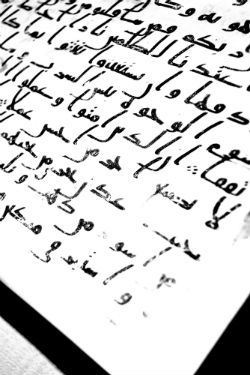A Qur’an manuscript held by the University of Birmingham has been placed among the oldest in the world, thanks to modern scientific testing.
Radiocarbon analysis dated the parchment on which the text is written to the period between 568 and 645 AD with 95.4 per cent accuracy. The test was carried out in a laboratory at the University of Oxford. The result places the leaves close to the time of the Prophet Muhammad, who lived between 570 and 632 AD.
Researchers concluded that the Qur’an manuscript is among the earliest written textual evidence of the Islamic holy book known to be in existence. This gives the Qur’an manuscript in Birmingham global significance to Muslim heritage and the study of Islam.
Susan Worrall, Director of Special Collections at the University of Birmingham, said: ‘The radiocarbon dating delivered an exciting result, which contributes significantly to our understanding of the earliest written copies of the Qur’an. We are thrilled that such an important historical document is here in Birmingham, the most culturally diverse city in the UK.’
 The Qur’an manuscript is part of Birmingham’s Mingana Collection of Middle Eastern manuscripts. Funded by Quaker philanthropist Sir Edward Cadbury, the collection was acquired to raise the status of Birmingham as an intellectual centre for religious studies and attract prominent theological scholars.
The Qur’an manuscript is part of Birmingham’s Mingana Collection of Middle Eastern manuscripts. Funded by Quaker philanthropist Sir Edward Cadbury, the collection was acquired to raise the status of Birmingham as an intellectual centre for religious studies and attract prominent theological scholars.
Consisting of two parchment leaves, the Qur’an manuscript contains parts of sura (chapter) 18 to sura 20, which were written with ink in an early form of Arabic script known as Hijazi. For many years, the manuscript had been misbound with leaves of a similar Qur’an manuscript, which is datable to the late seventh century.
Susan Worrall explained: ‘By separating the two leaves and analysing the parchment, we have brought to light an amazing find within the Mingana Collection.’
Alba Fedeli, who studied the leaves as part of her PhD, added: ‘The two leaves, which were radiocarbon dated to the early part of the seventh century, come from the same codex as a manuscript kept in the Bibliothèque Nationale de France in Paris.’
Explaining the context and significance of the discovery, David Thomas, Professor of Christianity and Islam and Nadir Dinshaw Professor of Interreligious Relations, said: ‘The radiocarbon dating of the Birmingham Qur’an folios has yielded a startling result and reveals one of the most surprising secrets of the University’s collections. They could well take us back to within a few years of the actual founding of Islam.
‘According to Muslim tradition, the Prophet Muhammad received the revelations that form the Qur’an, the scripture of Islam, between the years 610 and 632 AD, the year of his death. At this time, the divine message was not compiled into the book form in which it appears today. Instead, the revelations were preserved in “the memories of men”. Parts of it had also been written down on parchment, stone, palm leaves and the shoulder blades of camels. Caliph Abu Bakr, the first leader of the Muslim community after Muhammad, ordered the collection of all Qur’anic material in the form of a book. The final, authoritative written form was completed and fixed under the direction of the third leader, Caliph Uthman, in about 650 AD.
‘Muslims believe that the Qur’an they read today is the same text that was standardised under Uthman and regard it as the exact record of the revelations that were delivered to Muhammad. However, non-Muslims have often questioned this traditional account. Some scholars have suggested that the written text of the Qur’an was not completed until about a century after the death of Muhammad. They therefore argue that it contains some added elements that have nothing to do with the Prophet.’
He said the tests carried out on the parchment of the Birmingham folios yielded the strong probability that the animal from which it was taken was alive during the lifetime of the Prophet Muhammad or shortly afterwards. ‘This means that the parts of the Qur’an that are written on this parchment can, with a degree of confidence, be dated to less than two decades after Muhammad’s death. These portions must have been in a form that is very close to the form of the Qur’an read today, supporting the view that the text has undergone little or no alteration and that it can be dated to a point very close to the time it was believed to be revealed.’
The Qur’an manuscript will be on public display at the Barber Institute of Fine Arts for two weeks later this year.